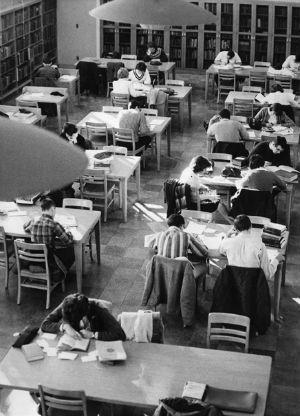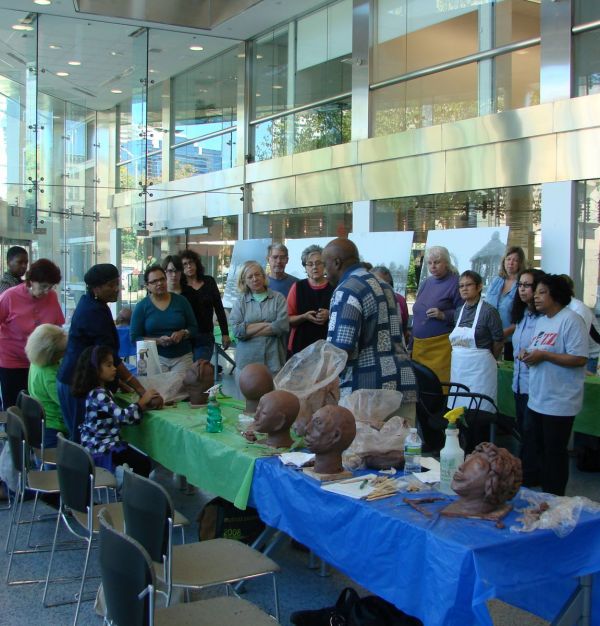.jpg) Hartford Public Library’s history spans more than 235 years. We can trace its very beginnings to the Library Company, formally organized in 1774. Started by a group of city leaders, its roster included the names of: Jonathan Brace, Jeremiah Wadsworth, Daniel Wadsworth, George Bull, Elisha Colt, Theodore Dwight, George Goodwin, Chauncey Goodrich and Thomas Y. Seymour. The Library Company served as a subscription company and opened with some 700 books. The library’s Hartford History Center has the original 1797 catalog in its archive and holds more than half of the original 700 volumes. The Library Company flourished into the early 1800s. It changed its name to the Hartford Library Company in 1799 and met in the Grammar School House, once located where the east end of the Municipal Building is today. Its first librarian was Solomon Porter, a Yale graduate and principal of the Grammar School.
Hartford Public Library’s history spans more than 235 years. We can trace its very beginnings to the Library Company, formally organized in 1774. Started by a group of city leaders, its roster included the names of: Jonathan Brace, Jeremiah Wadsworth, Daniel Wadsworth, George Bull, Elisha Colt, Theodore Dwight, George Goodwin, Chauncey Goodrich and Thomas Y. Seymour. The Library Company served as a subscription company and opened with some 700 books. The library’s Hartford History Center has the original 1797 catalog in its archive and holds more than half of the original 700 volumes. The Library Company flourished into the early 1800s. It changed its name to the Hartford Library Company in 1799 and met in the Grammar School House, once located where the east end of the Municipal Building is today. Its first librarian was Solomon Porter, a Yale graduate and principal of the Grammar School.
In 1838, Henry Barnard, a distinguished educator, rallied a group of young men together interested in providing a venue for lectures and debate. So began the Young Men’s Institute, later chartered as the Hartford Young Men’s Institute, a private association. The Hartford Young Men’s Institute invited Hartford Library Company subscribers to join with them, offering them lifetime memberships. Library Company members agreed and brought to the institute their collection, one that had blossomed from 700 books in 1774 to 3,000 volumes in 1838.
In 1843, Daniel Wadsworth offered the Young Men’s Institute a stake in what he hoped would become the cultural center of Hartford. Members accepted and, in 1844, the Young Men’s Institute moved into the new Wadsworth Atheneum, eventually sharing space with the fine arts gallery, the Watkinson Library, the Connecticut Historical Society and the Hartford Art School. In 1875, the Young Men’s Institute hired Caroline Hewins as its head librarian. She was 29 years old. She held the position for 51 years, until her death in 1926.

The institute’s lecture series was well attended for a number of years. Guest lecturers included Oliver Wendell Holmes, Horace Greeley, Dr. Horace Bushnell, Rev. Henry Ward Beecher, Samuel Clemens, Charles Dudley Warner and Ralph Waldo Emerson. But, by the late 1870s, the popularity of a lecture series began to diminish and the institute noted: “We have a library, not an institute; its members are, at least half of them, ladies; and the men belonging are old as well as young; being therefore, not alone for the young, not alone for men, and not an institute but a library, it seemed time to call it by its right name.” In 1878, the private institution applied for a name change and became the Hartford Library Association.
By the late 1800s, the people of Hartford recognized the need for a free public library. An agreement was struck between atheneum occupants with regard to property ownership and a request for funds went out to city residents so that the building could be modified with a new library wing added to the back of the original structure. Funds were also needed to pay for the ongoing maintenance of what was to become a new public literary and fine arts center.
More than 2,000 people donated money to this project. Hartford native Junius Morgan pledged $100,000 from London; his son, J.P. Morgan, pledged $50,000 from New York; other large donors included Lucy Morgan Goodwin and her sons J.J. Goodwin and the Rev. Francis Goodwin; the Keney brothers; and, Hartford banker Roland Mather. Contributions were made by the employees of Colt’s; Sigourney Tool; Case, Lockwood and Brainard Co.; Atlantic Screw Works; and, many other factories. School children contributed nickels and dimes – the complete list of donors, printed in the April 1, 1890 issue of The Hartford Courant, showed West Middle School kindergarteners contributing $2.90.

Within two years from the start of the campaign, the city raised an amazing $406,000. More amazing still, all was collected except for $145.00. On September 15, 1892, with the city appropriating tax monies for free library service, the doors of the new public library were opened. On the first day, 388 names were registered; by day ten, 2,160 names were entered. According to the library’s 1893 annual report, 101 people were counted as waiting at one time to borrow a book in the first month of the library’s opening. On May 3, 1893, by a special act of the general assembly, the library’s name was formally changed to Hartford Public Library. The library today operates under the original charter granted to the Hartford Young Men’s Institute in 1839, with subsequent amendments. The majority of the library’s operating cost now comes from city appropriations.
Today, Hartford Public Library sits a stone's throw from where the Library Company first began. From the Grammar School to the Wadsworth Atheneum, to the move to its modern facility at 500 Main Street in 1957 designed by Schutz and Goodwin, the 94,448 square foot building at 500 Main Street included modern reading and reference rooms. In 1998, to meet the fast growing needs of the community, the Library embarked on an ambitious 145,000 square foot expansion and renovation at a cost of over $42,000,000. It was completed in 2007. The Library, through all these wonderful growing pains, has had the support of the public. Hartford Public Library’s history continues to be distinguished by its service to the community and by the community’s enduring commitment to it.
 DONATE
DONATE











.jpg) Hartford Public Library’s history spans more than 235 years. We can trace its very beginnings to the Library Company, formally organized in 1774. Started by a group of city leaders, its roster included the names of: Jonathan Brace, Jeremiah Wadsworth, Daniel Wadsworth, George Bull, Elisha Colt, Theodore Dwight, George Goodwin, Chauncey Goodrich and Thomas Y. Seymour. The Library Company served as a subscription company and opened with some 700 books. The library’s Hartford History Center has the original 1797 catalog in its archive and holds more than half of the original 700 volumes. The Library Company flourished into the early 1800s. It changed its name to the Hartford Library Company in 1799 and met in the Grammar School House, once located where the east end of the Municipal Building is today. Its first librarian was Solomon Porter, a Yale graduate and principal of the Grammar School.
Hartford Public Library’s history spans more than 235 years. We can trace its very beginnings to the Library Company, formally organized in 1774. Started by a group of city leaders, its roster included the names of: Jonathan Brace, Jeremiah Wadsworth, Daniel Wadsworth, George Bull, Elisha Colt, Theodore Dwight, George Goodwin, Chauncey Goodrich and Thomas Y. Seymour. The Library Company served as a subscription company and opened with some 700 books. The library’s Hartford History Center has the original 1797 catalog in its archive and holds more than half of the original 700 volumes. The Library Company flourished into the early 1800s. It changed its name to the Hartford Library Company in 1799 and met in the Grammar School House, once located where the east end of the Municipal Building is today. Its first librarian was Solomon Porter, a Yale graduate and principal of the Grammar School.


